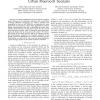Free Online Productivity Tools
i2Speak
i2Symbol
i2OCR
iTex2Img
iWeb2Print
iWeb2Shot
i2Type
iPdf2Split
iPdf2Merge
i2Bopomofo
i2Arabic
i2Style
i2Image
i2PDF
iLatex2Rtf
Sci2ools
VTC
2010
IEEE
2010
IEEE
Analysis of Local Quasi-Stationarity Regions in an Urban Macrocell Scenario
—A common simplification in the treatment of random linear channels is the wide-sense stationary and uncorrelated scattering (WSSUS) assumption. For wireless channels, this assumption is, however, only fulfilled in an approximative sense inside local time-frequency regions. Since algorithms in wireless digital communications often rely on knowledge of second order statistics of the channel, it is important to know the size of local quasi-stationarity regions. Thus, we determine quasi-stationarity regions in distance for an urban macrocell scenario. We observe that, based on the chosen measure and in our specific scenario, the time-frequency properties are dominant compared to the spatial properties in defining the size of quasi-stationarity regions. Furthermore, we find that in some cases the quasi-stationarity regions strongly depend on the mobile terminal orientation.
Communications | Local Time-frequency Regions | Quasi-stationarity Regions | VTC 2010 | —A Common Simplification |
| Added | 31 Jan 2011 |
| Updated | 31 Jan 2011 |
| Type | Journal |
| Year | 2010 |
| Where | VTC |
| Authors | Adrian Ispas, Gerd Ascheid, Christian Schneider, Reiner S. Thomä |
Comments (0)

